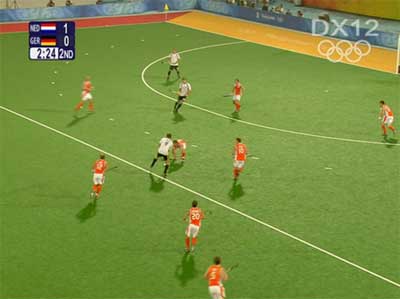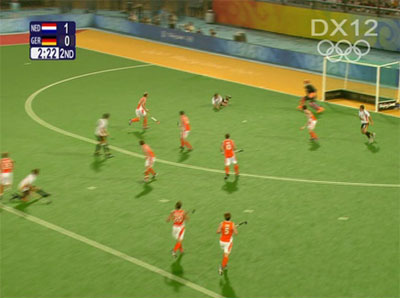The Most Valuable
Play Making Space
On The Hockey Field

For more coaching information, visit www.coachshiv.com
| January | February | March |
|
April | May | June |
|  |
|||||
| July | August | September | October | November | December | |
![]()
INTRODUCTION
Just like the prime downtown area of a metropolitan city is far more expensive and valuable than its outlying areas, in the same way, there are certain zones on the the hockey field which are far more valuable than other zones in achieving the team objectives.
Top coaches are aware of this "concept of location". They understand the varying importance of each zone of the field; and exploit it to its optimum advantage.
The focus of this month's article is a very specific zone of the field known as the play making space. Its location is in front the opponent's circle, on the right side. The right inner of the attacking team play takes on the role of the play maker in this zone. The passes generated from this space to the leading forwards result in classy goals that make the highlight reels, often leaving the defenders clueless.
WHY IS THE PLAY MAKING SPACE SO VALUABLE?
There are many reasons why the play making space is the most valuable real estate on the hockey field.
1. It presents the most optimal view to the right inner, with regards to the position of the opposing defenders and his/her leading forwards.
2. The leading forwards receiving the ball from the right inner will have multiple options - they can receive it on their open stick or reverse stick
3. Once having received the ball, the leading forwards will have multiple options to finish the move - they can slam, push, make a first time hit, or if the pass from the right inner was at the right speed and position, gracefully deflect the ball into the goal.
EXAMPLE
| Germany vs. Netherlands - 2008 Beijing Olympics Semi-final | |
 |
 |
In the above frame grabs taken 2 seconds apart, Germany's Nos. 9 is with the ball in the play making space, and has the Dutch defender committed and on his heels. The German player has two leading forwards on his left side. Germany gets a free hit outside the circle. Number 9 takes it quickly and makes a defence-splitting pass to the waiting forward on the left goal post, resulting in the equaliser. Germany went on to win this game, and eventually the Beijing Olympic Games hockey gold medal.
USAGE IN WORLD LEVEL TOURNAMENTS
| 2008 Beijing Olympic Games |
In the men's semi-final between Australia and Spain, the game was less than 1 minute old when Australia scored a beautiful field goal from a cross that was initiated by the right winger and the subsequent pass which came from the play making space.
| 1984 Los Angeles Olympic Games |
In the men's semi-final between Australia and Pakistan, the only goal of the match came when Manzoor Jr. made a pass to centre-forward Hasan Sardar from the play making space.
Australia was the favorites to win the Olympic gold medal at Los Angeles. This was Australia's all-time-great team, and they came in to the tournament having not lost in their prior 55 matches. The Australian men's team eventually finished medal less at the Los Angeles Olympics.
| 1994 Sydney World Cup |
In the final between Pakistan and Netherlands, Pakistan's only goal during regulation came from a pass from the play making space by right inner Tahir Zaman.
The final ended up tied 1-1, and Pakistan eventually won in the tie-breaker 4-3 to win their record 4th World Cup.
I end this section with a story. A couple of years ago I was talking to Terry Walsh in Simi Valley, CA, USA. Terry played as a centre-forward for Australia in the early 1980s, with Ric Charlesworth playing the role of right inner.
Terry once had an opportunity to play as a centre-forward with Manzoor Jr., right inner from Pakistan, in a charity match in the mid 1980s. His fond memories of that match were the timely and soft passes he received from Manzoor Jr., with pinpoint accuracy and pace. Terry had no trouble receiving the well placed passes on the run and finish the play.
The two great right inners of the decade of the 1980s were Manzoor Jr. and Ric Charlesworth, and Terry had the good fortune to play with both.
CONCLUSION
What should the coach do to maximize the advantage of this play making space?
The first step is to be aware of this space and its importance. The second step is to identify players who can play at this position (right inner or right link), and train them with the necessary technical skills and tactical thinking.
The right inner has to be intelligent, with a good vision of the goal area and the leading forwards. The right inner should posses very good technical skills - stickwork, ball control and deceptive passing, attract the opposing defenders like a magnet, and than pass the ball effortlessly to the leading forwards.
The right inner's style of play is very unique, and require special receiving skills, moves, semi-penetrating dodges to fulfill the play maker role, played with perfection by Manzoor Jr. of Pakistan in the 1984 Olympics.
Since the beginning of the millenium, the role of the right inner as the play maker to the leading forwards has been fading in modern hockey. This is point to think over, both for the coaches and the players, on how to best utilise the play making space to the team's advantage.
![]()